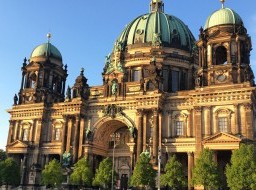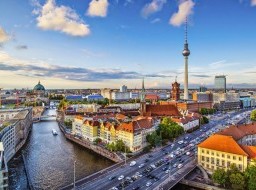Alexanderplatz is a central square and traffic junction in Berlin's Mitte district. One of city's the most visited squares, Alexanderplatz is the site of many attractions and sights in Berlin.
"Alex" to Berliners, a cattle market in the Middle Ages, a military parade square and an exercise ground for nearby barracks until the mid 19th century - Alexanderplatz is the square named to honour Alexander I, Tsar of Russia, on his visit to Berlin in 1805. It was here that Alfred Döblin took the pulse of the cosmopolitan metropolis portrayed in his 1929 novel "Berlin Alexanderplatz" filmed by Fassbinder for a TV series as a portrait of the bustling city in the 1920s before the imminent Nazi takeover. Fast forward to more recent times, one million people congregated here, on 4 November 1989 to demonstrate against the GDR regime shortly before the fall of the Berlin Wall. This was the largest anti-government demonstration in its history.
Alexanderplatz epitomizes Berlin's urban history
Layer upon layer of Berlin's urban history is located in Alexanderplatz, interweaving centuries of social, political, and architectural history and repeatedly the subject of public debate and urban design competitions. The transformation of Alexanderplatz into a modern transit junction and shopping area came about during the second half of the 19th century with developments such as the construction of the S-Bahn, Berlin's surface rail network in 1882 and the underground railway from 1913. Devasted during the war the square gradually developed into the pedestrian zone during the 1960s becoming a popular if rather amorphous urban area.
Alexanderplatz: Centre of East Berlin
Many of the well known buildings, examples of East Berlin's attempt to compete with the Western side's own in-your-face high-rises were erected during this time: The "Hotel Stadt Berlin" – a 123 meters high hotel, the "Haus des Lehrers" (Teachers' House), a venue for pedagogues which remained more of a representative façade than a real educational forum, the "Haus des Reisens" (House of Travel) with a slightly amusing ring to it given the notorious travel restrictions during the GDR, and the publishing house building - today's Berliner Verlag – with offices of the Berlin daily, Berliner Zeitung.
Socialist urban aesthetics at Alexanderplatz
In the 1970s under Erich Honecker Alexanderplatz became an experiment in socialist urban aesthetics. The honeycomb aluminium façade of the former "Centrum Warenhaus", (Kaufhof Group today) was the largest department store in the GDR and is today a transformed department store designed by Josef Paul Kleihues.
Major sights at Alexanderplatz
Amongst the sights to look out for here are the 365 metre TV Tower, Berlin's highest construction topped by a globe (turned into a pink football during the 2006 World Cup Event) with a rotating viewing platform. The "Brunnen der Völkerfreundschaft" (Fountain of Friendship amongst Peoples) and the landmark World Time Clock erected in 1969 serve as popular meeting places. Berolina House by Peter Behrens now houses a large retail clothing store. The Alexa shopping mall was opened in 2007, and a multiplex cinema attracts a number of film enthusiasts every day.





